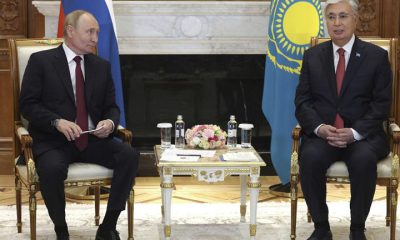SportsNews
Three brand new branded buses for Heartland Football Club of Owerri have arrived at the State House, Government House Owerri, and are set to be handed over to the teams. Both the men’s and women’s teams will benefit from this.

SportsNews
EPL: Full list of players leaving for 2025 AFCON

At least 25 players in the Premier League are set to travel for the 2025 Africa Cup of Nations in Morocco.
The tournament is scheduled to take place from December 21, 2025, to January 18, 2026.
Nigeria, Ivory Coast, DR Congo lead the way in terms of players based in the English topflight, with four selected from each club for the AFCON.
FIFA has directed clubs to release the eligible players from Monday, December 15.
Full list of players confirmed
Sunderland (5):
Chemsdine Talbi (Morocco), Reinildo (Mozambique), Bertrand Traoré (Burkina Faso), Arthur Masuaku (DR Congo), Noah Sadiki (DR Congo).
Manchester United (3):
Bryan Mbeumo (Cameroon), Amad Diallo (Ivory Coast), Noussair Mazraoui (Morocco).
Fulham (3):
Alex Iwobi (Nigeria), Calvin Bassey (Nigeria), Samuel Chukwueze (Nigeria).
Burnley (3):
Axel Tuanzebe (DR Congo), Lyle Foster (South Africa), Hannibal Mejbri (Tunisia).
Nottingham Forest (2):
Ibrahim Sangaré (Ivory Coast), Willy Boly (Ivory Coast).
Brentford (2):
Dango Ouattara (Burkina Faso), Frank Onyeka (Nigeria).
Manchester City (1):
Omar Marmoush (Egypt),
West Ham United (1):
Aaron Wan-Bissaka (DR Congo)
Wolves (2):
Tawanda Chirewa (Zimbabwe), Emmanuel Agbadou (Ivory Coast).
Brighton & Hove Albion (1):
Carlos Baleba (Cameroon).
Crystal Palace (2):
Ismaïla Sarr (Senegal), Cheick Doucouré (Mali)
Liverpool (1):
Mohammed Salah (Egypt)
SportsNews
NNL bars fans from Ranchers Bees vs Adamawa United

The Nigeria National League, NNL, has announced that matchday six fixture between Ranchers Bees and Adamawa United will be played behind closed doors.
The announcement was made in a statement by the league body.
Only the State Football Association representatives, staff of both teams, kit managers and medical personnel will be allowed into the stadium.
Others are the match officials, security personnel and camera men.
The reason for the decision to play the game without club supporters wasn’t stated by the league body.
The encounter will take place at the Bako Kontagora Stadium in Minna on Saturday (today).
SportsNews
Nigeria vs Egypt Friendly Gets New Date

Nigeria’s preparations for the 2025 Africa Cup of Nations have taken a fresh hit, with Egypt confirming that the highly anticipated friendly between both nations has been shifted from 14 to 16 December.
The Egyptian Football Association (EFA) announced the adjustment late Friday, noting that FIFA’s updated international release directive, which allows clubs keep African players until 15 December, made the original date unworkable.
EFA Vice President Khaled El-Darandaly explained that the new rule left both Egypt and Nigeria without full squads for the initial date.
Key Pharaohs players, including Mohamed Salah and Omar Marmoush, are now expected to arrive only after the new release window.
Egypt had already named its 28-man provisional squad and opened camp in Cairo, with head coach Hossam Hassan accelerating final preparations for a Group B campaign that includes South Africa, Angola and Zimbabwe.
Nigeria’s disruption is more extensive. The Super Eagles were originally scheduled to open camp on 10 December and progress through a streamlined friendly schedule before departing for Morocco. That entire framework has now been dismantled.
Under the revised timeline, camp will open on 14 December, leaving Eric Chelle with barely a week to prepare before AFCON kicks off.
The venue for the friendly is also now uncertain, with Cairo no longer feasible and both federations considering shifting the match to Morocco.
Nigeria’s build-up has been further destabilised by injuries to Ola Aina, Taiwo Awoniyi, Benjamin Fredrick and Felix Agu.
The shock retirement of captain William Troost-Ekong, winner of the 2023 AFCON Player of the Tournament award, creates an additional leadership vacuum in defence.
Chelle, who released a 55-man provisional list, must now trim his squad to 28 within a compressed window. Nigeria will compete in Group C alongside Tunisia, Uganda and Tanzania as they chase a fourth continental title.
-
Business1 year ago
US court acquits Air Peace boss, slams Mayfield $4000 fine
-

 Trending1 year ago
Trending1 year agoNYA demands release of ‘abducted’ Imo chairman, preaches good governance
-

 Politics1 year ago
Politics1 year agoMexico’s new president causes concern just weeks before the US elections
-

 Politics1 year ago
Politics1 year agoPutin invites 20 world leaders
-

 Politics1 year ago
Politics1 year agoRussia bans imports of agro-products from Kazakhstan after refusal to join BRICS
-
Entertainment1 year ago
Bobrisky falls ill in police custody, rushed to hospital
-
Entertainment1 year ago
Bobrisky transferred from Immigration to FCID, spends night behind bars
-
Education1 year ago
GOVERNOR FUBARA APPOINTS COUNCIL MEMBERS FOR KEN SARO-WIWA POLYTECHNIC BORI














